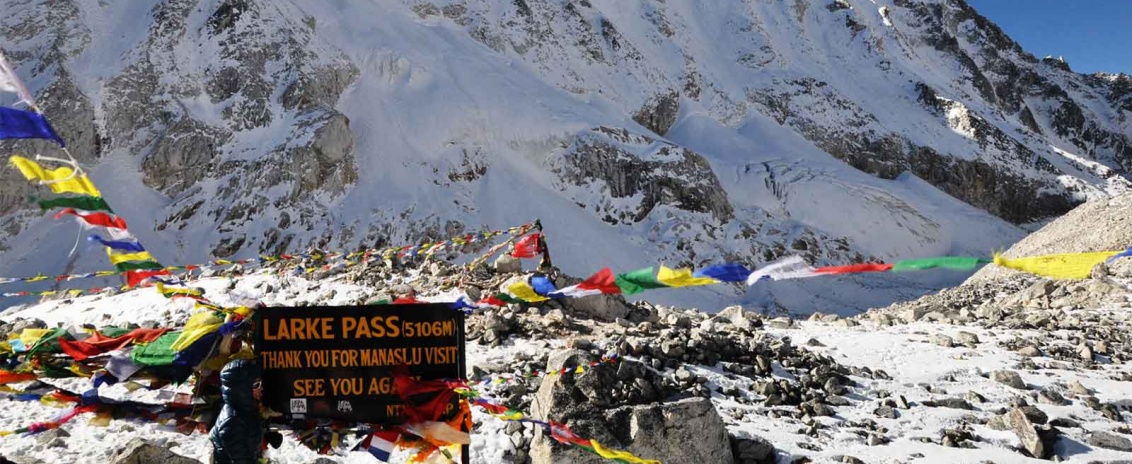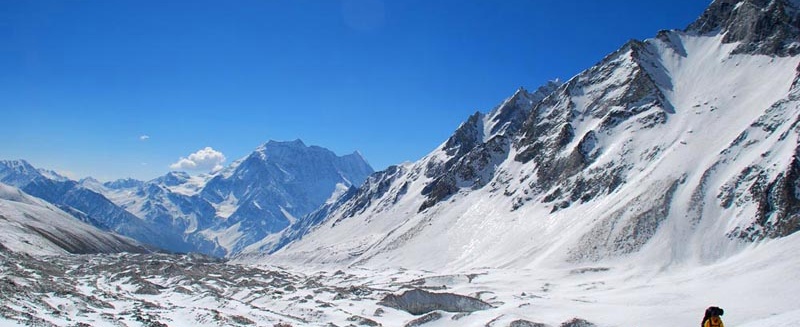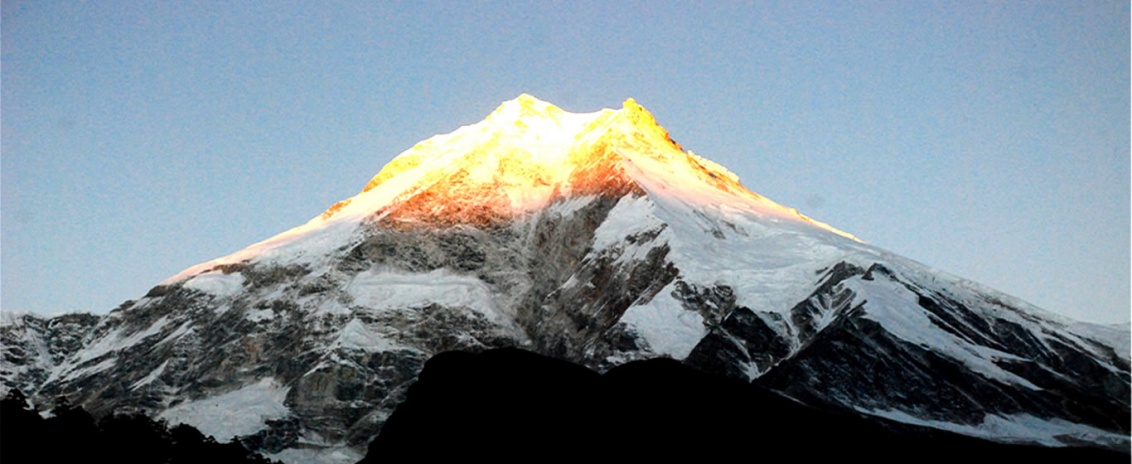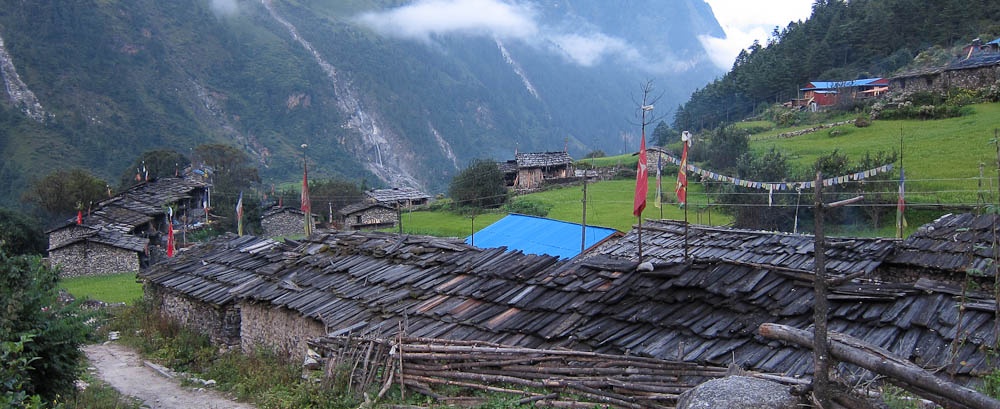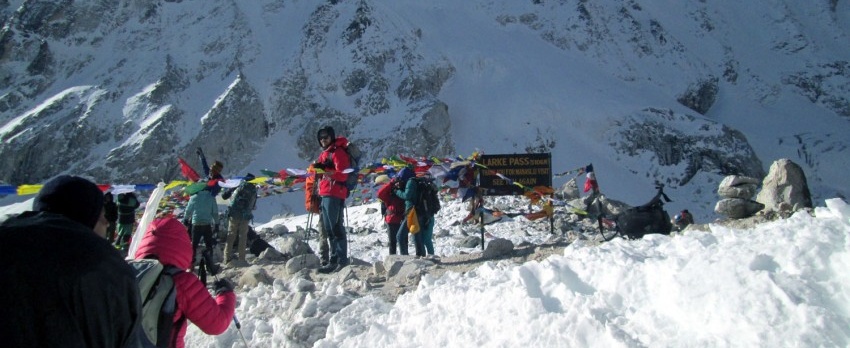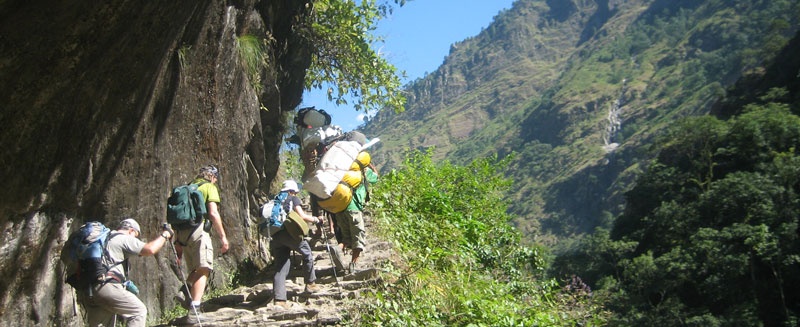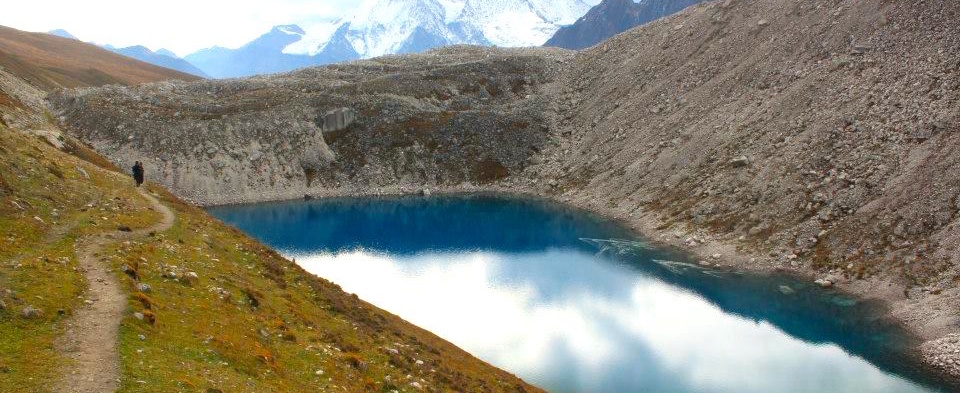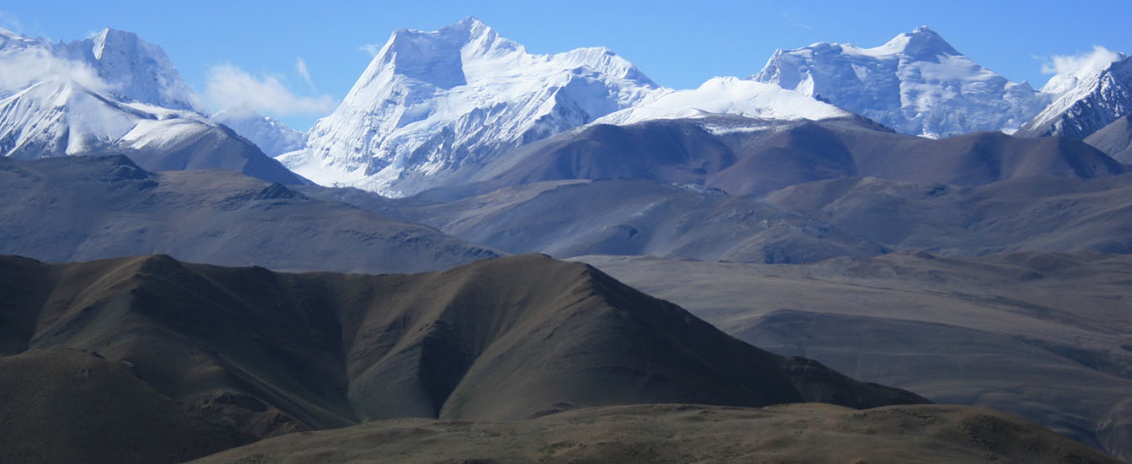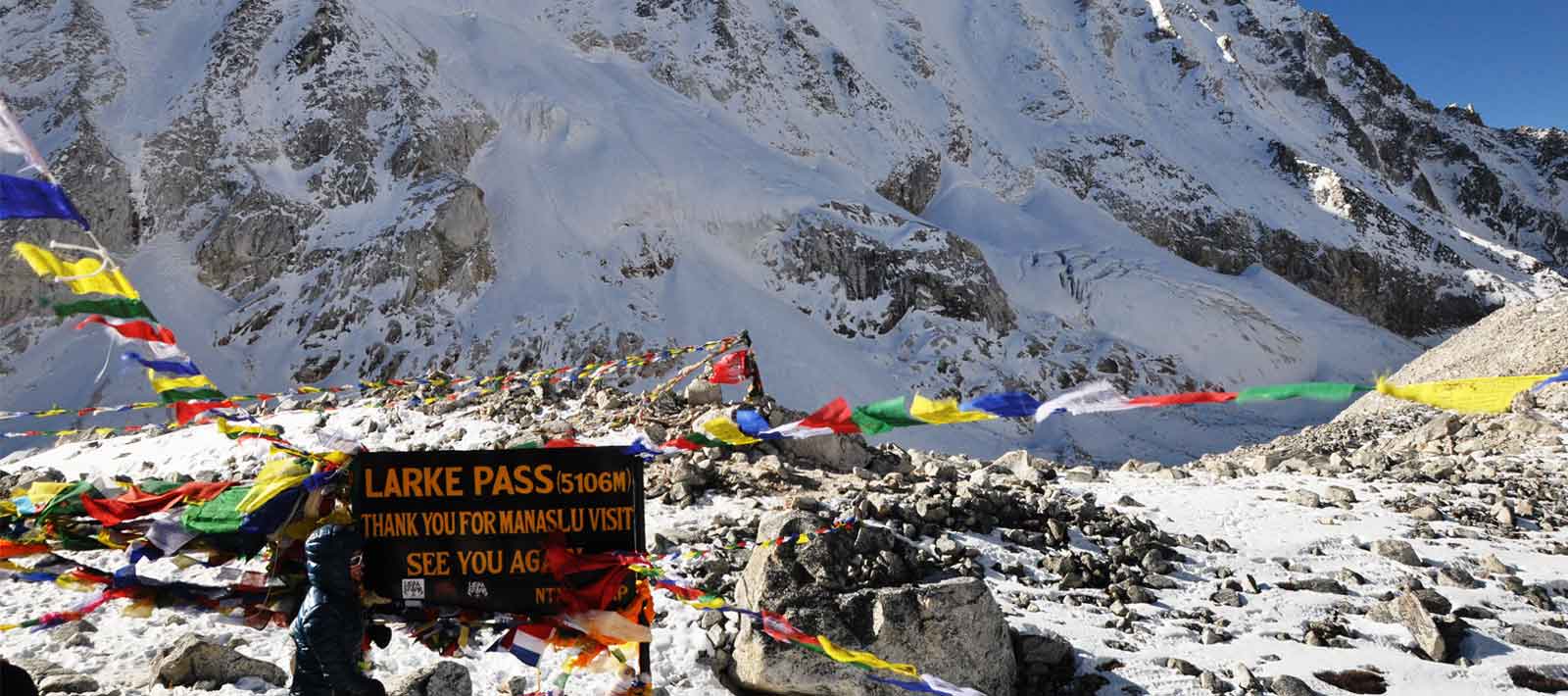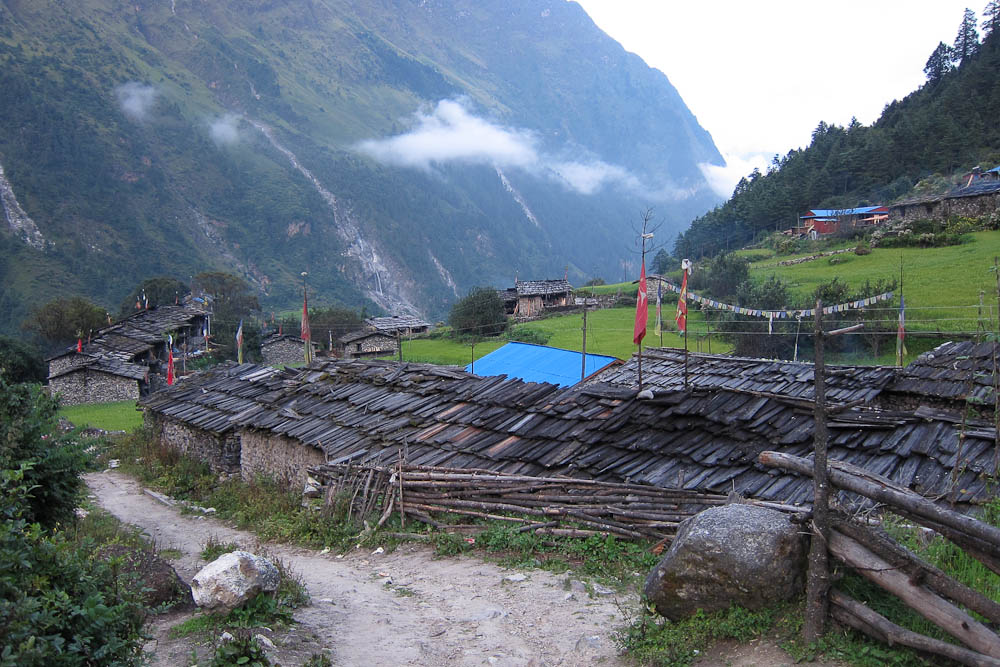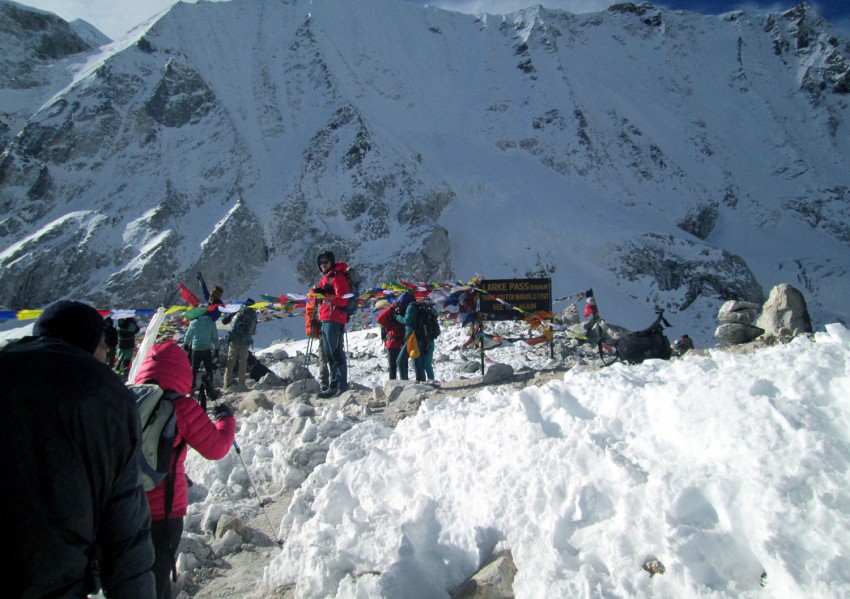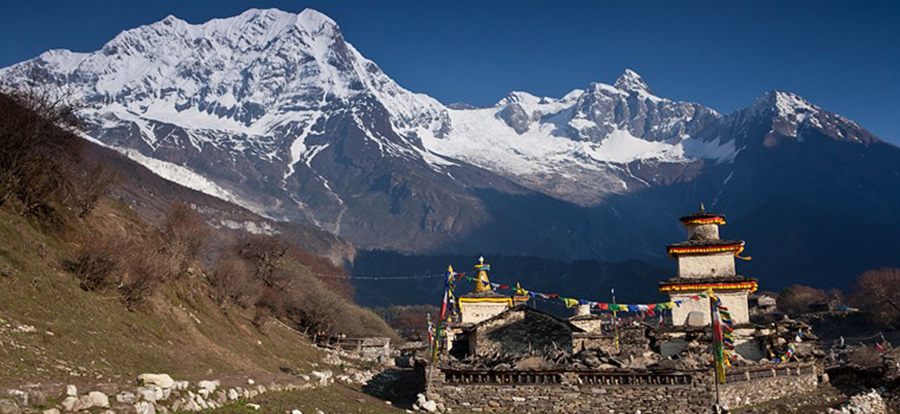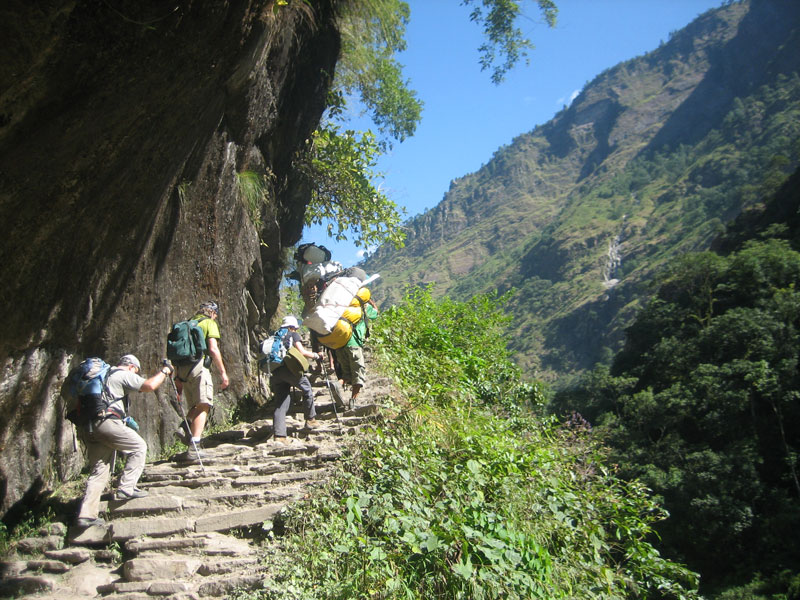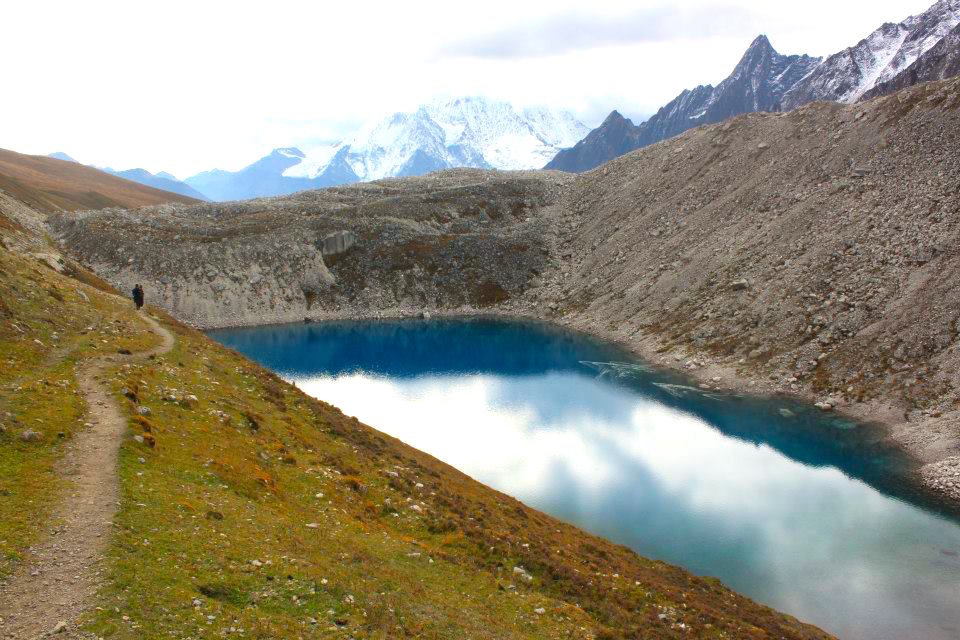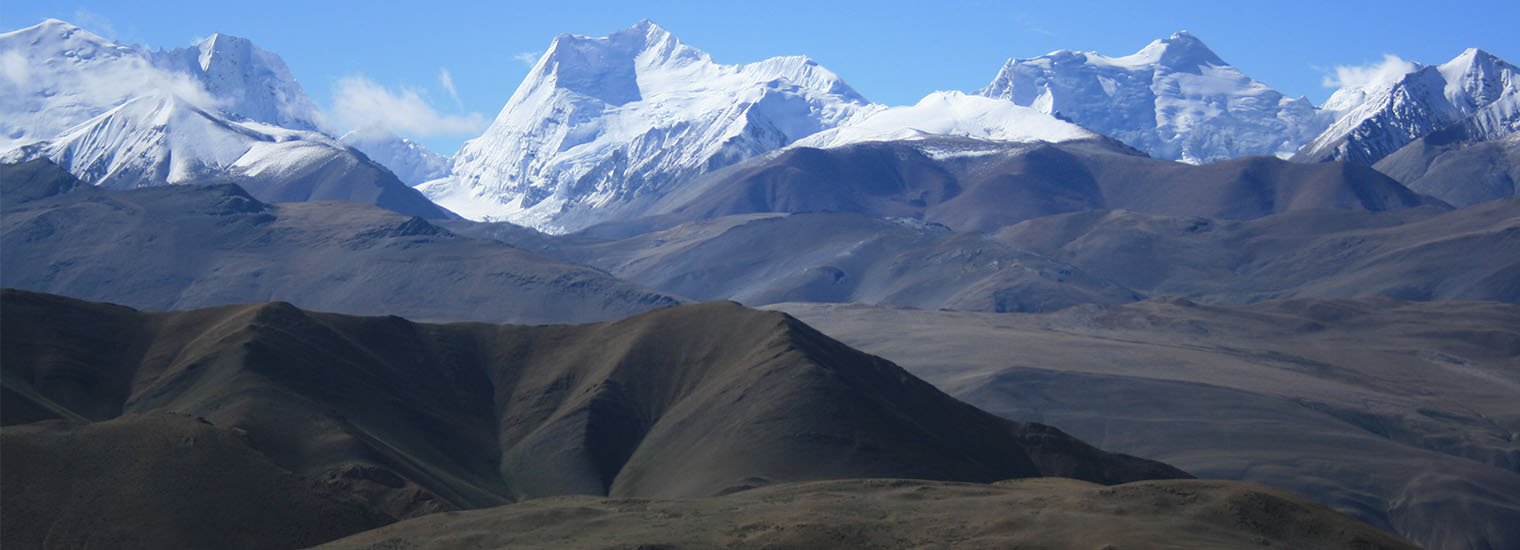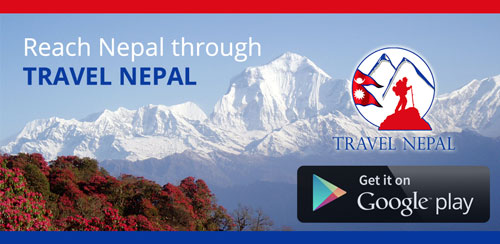Let's explore the western region of Nepal in the Manaslu area housing world's eighth highest peak, Mt. Manaslu 8163 meters. Mt. Manaslu (also known as "the peak of the spirit") was only open to visitors in 1992. There are still no open hiking routes, but it attracts tourists from all over the world. This tour will allow us to stand in the natural environment of the Himalayas, where the beauty of the scenery makes people hold their breath.
In this trek we will take a round in the Manalu area. This trek starts from Arughat of Dhading and continuing to the hills and mountain of Gorkha district. Along the trek we will enjoy panoramic views of mountains, cross many rivers and streams and pass through dense forest experiencing everything in purest and untouched form.
Cost Includes:
15 night accommodation with 3 meals a day during trek
3 night accommodation in Kathmandu on Bb plan
All entrance and Permit charge
Special permit of restricted area
Licensed Guide and Porter
All transfer; airport drop pick up
Bus or Jeep fare Kathmandu - Arughat
Bus or Jeep fare Bulbhule -Kathmandu
Farewell Dinner
DAY 01: Kathmandu
Arrival
Welcome to Nepal. First day you’re in Nepal. Our
representative will be at the airport to receive you and transfer to Hotel. Our
manager will meet you at hotel or where convenient and brief you about the trek
along with introduction to guide of the trek. Overnight at Hotel on B plan
DAY 02: Kathmandu
We stay in Kathmandu and prepare equipment and things for
the upcoming adventure. Besides preparation, you can go for a day sightseeing. Before
noon our guide will take you to visit the Swayambhunath temple, a Buddhist
stupa with a 2000-year history that rises on a hill and opens a fascinating
view of the city of Kathmandu. After lunch, you’ll visit Kathmandu Durbar
Square and Patan Durbar Square. Both of these palace complexes once were
residence of Kings of Nepal of the Malla and Shah dynasty. After a full day
sightseeing, you’ll be transferred to Hotel. Our representative will brief you
about the trekking.
DAY 03: Kathmandu to
Arughat (550 m)
After breakfast, we will start the journey. We will take bus
or jeep (according to number of group members) which will take around 7 hours
to get there. During the period, we will cross the highway, vibrant villages
with beautiful fields. In Arughat market, we will have a preliminary feeling of
the rural landscape of Nepal. We will spend overnight at Arughat.
DAY 04: Arughat to Soti
Khola (720 m)
The start of the day will be at the hotel with
breakfast. Then we will proceed from the Arughat market to Soti Khola. The
walking tour will be along the Budhi Gandaki River. Then we will have lunch
somewhere on the way. Today we will stop at Soti Khola overnight stay so
you can relax. It is good to rest here as you can swim in the beautiful crystal
clear river.
DAY 05: Soti Khola to
Machha Khola (930 m)
After breakfast, you will start a walk from Soti Khola to
Machhakhola. It will be up to 7 hours of hiking, during which we will pass
through the unspoiled natural forests, colorful villages, clean and clear
streams, spectacular waterfalls and green mountains, and then arrive at Lapu
Besi village. The main inhabitants of this village are the Mongolian. Then, we
will continue our hiking, through the winding path, and finally arriving at
Macchakhola where we will stay for overnight.
Day 06: Machha Khola to
Jagat (1,440 m)
After breakfast at the small hotel, we will walk towards
Jagat. Today we will walk for 7 hours, and we will go to the upper part of the
village of Kharola and the spa or hot springs of Tatopani. The valley is very
steep while some of the paths of this trail are quite exposed and challenging,
but this still holds a wild beauty. After walking between woody forests, we
will arrive at Doban. At Doban, we can see Budhi Gandaki River descending at an unimaginable
speed. We will cross the river with a bridge and then climb the Jagat area from
a high path. We will be resting here for a night at a small hotel at Jagat.
DAY 07: Jagat to Deng (1,860 m)
Today we will leave for Deng. It might take around 6 hours
to complete today’s trek however it will be rejoicing as we walk gentle uphill,
followed by a flat road then we reach to Philim. Philim is a big village; its
main inhabitants are Gurung. Here, we can see the tranquil temples, the winds
of the chortens and the prayer of the flag, as well as the mountain classic and
solid hut. We continue to walk along a flat road, most of which is shuttle in
the pine, azalea and cedar forest. In the course of walking, we will cross some
bridges and also watch the colorful rush roofs. After trekking few more hours ,we
will reach to Deng. Deng is a village famous for its potatoes, buckwheat,
barley, wheat, cabbage and spinach, because most of the people here are mostly
involved in farming. We will stay overnight at Deng.
DAY 08: Deng to Namrung (2,560 m)
After breakfast at hotel, we will start walking from Deng to
Namrung. We will walk along the flat road, then climb uphill, and pass through
the dense woods. Here we will be able to watch the unforgettable views of
Manaslu, hills, green canyons and numerous bridges. Namrung is a Buddhist
village, where there are many temples, hydro power houses, Mani wall, chortens
with the banner of flying prayers in the wind. We will stay overnight at
Namrung.
DAY 09: Namrung to
Lhogaon (3,180 m)
The next walk is from Namrung to Lhogaon, about 4 hours.
After breakfast our trek will begin at the twists and turns of the Himalayas.
On the way, there will be an opportunity to watch the scenery of Rupinala,
Manaslu Peak, Gurkha Snow Mountain, and other silver-gray mountains. As we trek
to some height we will feel some change in climate because the higher the
altitude, the thinner the air. Thus, afternoon walk will be relatively cold and
will windy. On the way, we will pass Mani wall, chortens, praying for the
banner with the temple. Before reaching Lhogaon, we will pass through some
Tibetan village. The Lhogaon Bridge has a Buddhist monastery with Buddhist
monks and Buddhist schools. Overnight at Lhogaon
DAY 10: Lhogaon to
Samagaon (3,360 m)
Today’s trek will be from Lhogaon to Samagaun, which will
take around 4 hours. After breakfast, we will leave the village and start our
trek. We will walk along the right bank of the river, and watch the views of
peaks above 6000 m. If you will see main road approaching, then it suggests we
are close to Samagaon. We will stay overnight at Samagaon.
DAY 11: Samagaon
Today we will rest at Samagaun to acclimatize and relax with
lots of tired hands and feet because of the long intensity of hiking. This also
allows the lungs to relax, so that the breathing system can adjust and adapt to
the new altitude. In the tranquil woods surrounded by mountains, we will have a
short adjustment and rest time. During the period, we can see the beauty of
Samdo (Pang Phuchuli), Nagdi Chuli, Simnang Himal and many other peaks. You
have another option to go for excursion tour to the Makalu Base camp. Overnight
at Samagaon
DAY 12: Samagaon to
Samdo (3,780 m)
We will start walking from Samagaun towards Samdo for 4 hours.
Today we will climb a gentle uphill road through a desert road with a windy
canyon. The border line of Tibet is only four kilometers away from Samdo, but
tourists are not allowed to cross the border line. There is a Tibetan refugee
village here. Here you can see the great view of Manaslu, Samdo (Pang
phuchuli), Nagdi Chuli, Simnang Himal and other beauty. We will rest at Samdo
DAY 13: Samdo to Larkya
Phedi (4,460 m)
From Samdo we will walk to Larkya La Phedi, which will take
3 hours. The road to today’s destination is rocky full of twists and turns.
Before arriving at Larkya La Phedi, we will pass a market called Larkya, where
there are some seasonal products sold by local residents. Overnight at Larkya
Phedi
DAY 14: Larkya Phedi to
Bhimthang (3,700 m)
Today we will walk towards Bhimthang via Larkya La Pass (5,106 m).
This day will be a little tough, because we need to go to Larkya La. We pass
through the overlapping rock and twists and turns of the road; climb the steep
uphill in order to reach Larkya La. At the top of the hill, you will be able to
enjoy the top view of the Larkya, sunrise, Manaslu, Ratna Chuli, and many other
snow-covered peaks. Walking through this road, we will pass through the rocky
-steep downhill road. Bhimthang is a wide level of ablation of the valley, and
there are many Mani wall with uninhabited houses. Overnight at Bhimthang
DAY 15: Bhimthang to
Dharapani (1,860 m)
Today we will trek towards Dharapani whcih will take 7
hours. We will cross rivers and get on the ridge. On the 4150-meter-high ridge,
it will be nice to watch Manaslu as well as Annapurna II on its southeast
direction. In the upper reaches of Dudh Khola, we will enter the azalea forest,
and then walk through a narrow valley, and then to the Karche valley, the
highest cultivated area. We will go down and walk through a stream to Tilje.
Wine of Tilje is famous. After an hour's walk from Tilje, we will reach
Dharapani and stay there overnight.
DAY 16: Dharapani to
Jagat
Today’s walk will take 6 hours from Dharapani to Jagat. The
whole journey will be along the river bank of Dudh Khola and Marshyangdi. On
the way, we will go through some delightful villages, such as: Taal. Taal is a
very charming village, where there are beautiful waterfalls, and here you can
enjoy the dense scenery of the Castle Peak. Finally, we will pass through the
stone village and then reach the steep Canyon. Finally, we will stay overnight
at Jagat
DAY 17: Jagat to
Bulbhule
It will take 6 hours from Jagat to reach Bulbhule. We will
walk on a steep downhill road. Today our trekking comes to an end on arrival at
Bulbhule. Take good rest and enjoy your last night in the mountain.
DAY 18: Bulbhule to
Kathmandu
On the 18th day we will travel from Bhulbhule to Kathmandu,
which will take around 7 hours. Along the banks of Marshyangdi and Trishuli, we
will be able to see the beautiful scenery of the mountains, farmland and
colorful villages. Upon arrival in Kathmandu, we will head to the hotel. We did
everything, so you can spend your time quietly, exchanging e-mail addresses and
photos with the rest of the group. Evening can be spent in a relaxed atmosphere.
Perhaps, go for the latest purchases. And then, together with the whole team of
Nep Travels will provide you a farewell dinner or lunch. Overnight at Kathmandu
DAY 19: Departure
Say goodbye to the mountains, because your journey through
Nepal has come to an end! We hope that you liked the trip organized by us, and
we are sure that you will return to the Himalayas! Approximately 3 hours before
the departure of your aircraft, our representative will take you to the
airport. On the way home, you have enough time to plan your next adventure in
the wonderful country of Nepal.
Cost Excludes:
Visa Fee (free for Indian, Chinese and SAARC nationalities except for Afghans)
Lunch and Dinner in Kathmandu
Travel Insurance
Rental charge for sleeping bag and down jacket
Expenses during trek like charging electronic devices, WI-FI, hot shower, toilet paper rolls, mineral water, and other personal items
Tips to guide and porter
Travel Insurance:
About the travel insurance we suggest our guest to take those insurance which covers all emergency case or other travel related injury during your travel in Nepal. However, this is optional and it depends on your opinion. If you are buying any insurance you can buy which covers for a week or only for days you will be in Nepal.
There are many insurance companies, but we suggest you to get World Nomad. They have emergency evacuation even up to 6000m. But before you get it make sure you are covered for such evacuation. For those who already have insurance of other company, make sure if it covers travel insurance in Nepal and especially evacuation up to 6000m. Link for World Nomads is www.worldnomads.com
Cancellation and Refund:
Although it’s rare but sometimes we might cancel trip due to some internal problems, in such a case you will be refunded full amount of package. If guest wish to cancel trip then money will be refunded as following:
Cancelled one month before arrival full refund
Cancelled 15 days before arrival 75% refund of total cost
Cancelled one week before arrival 50% of total cost
Cancelled less than a week 25% refund of total cost
No Show No refund
Equipment and
Accessories
Trekking on the high altitude area there is some requirement
of equipment.
Sunglasses
Sunhat, cap or Scarf
Woolen hat
Head light and torches
Gloves
Thermals
Fleece
Comfortable trekking boots
Fleece pants
Jackets, down jacket
Sleeping bag rated to -20°C
Trekking poles
Trekking bag or Duffel bag
Water bottle
Sunscreen
Toiletries
Spare battery (if you
have any to charge your electronic devices on the way)
- Can I travel alone without guide, just with a porter?
Well it’s your choice whether you want a guide or not. But what we suggest you, is to take a guide because there are thousands of solo traveler missing in Nepal. If there is a guide to assist you, you don't have to worry about where to stay for a night; how to find your way, how do you arrange your everyday trip and how do you take care of yourself if there are any bad happenings. Moreover, mountains are not like city area where you will find many to communicate, In the mountain very few speak English, and we remind you not to believe anyone you meet on the way cause there are good and bad people everywhere.
- What age people can trek in the Mountains?
There is no limit in age unless you are below 18 yrs. old. Everyone can trek if their physical strength allows them. If there is kid interested, then he/she must be accompanied by his/her parent. For those above 18 don’t have any restriction. Before you choose any trekking destination consult with your physician and then go for that which you can complete.
- How long is the trekking? How long will be the walking trail?
Trekking depends on the kind of package you choose. There are packages of a week and even of 3 weeks and more. When you are trekking average hour you will trek is four to six hours, in some cases 7 hours a day, which will be minimum of 7km and maximum 15 km of walking in a day.
- Is it compulsory to have previous trekking history?
No, if this is your first time then it's OK. Not all the trekkers have previous experience. There are many beginners who do well than those experienced ones. Before you come to Nepal indulge yourself in some walking or stamina building sports, so that it becomes easier for you to even walk for 6 hours a day.
- What things do I need to prepare before coming to Nepal?
Documents:
You will require documents like passport, color copies of passport, passport size photo graphs, if you are below 18 and travelling with friends, you will require a written document by your parents (travel agreement), if you are going under medication, written prescription by doctor is required. Besides these, if there are any other compulsory documents we will inform you during booking. For any other information you can check our travel essentials where information about Customs, Visa and Travel tips is given.
Equipment:
You will require that equipment which is listed in Equipment list. Please check there. You are free to carry other item if you need even if not mentioned in the list.
Travel Insurance:
Apart above mentioned, most important thing you will require is Travel insurance. As, we've said it's optional but it’s better if you have one. There are many insurance companies, but we suggest you to get World Nomad. They have emergency evacuation even up to 6000m. But before you get it make sure you are covered for such evacuation. For those who already have insurance of other company, make sure if it covers travel insurance in Nepal and especially evacuation up to 6000m. Link for World Nomads is www.worldnomads.com
- What permits are required and who will arrange it for us?
For every trekking, either short or long you will require permits. For all trekking region you will require TIMS (Trekker's Information Management System). We will get it for you and you should prepare a photograph for it. Another is National Park permit. For every trekking region which falls under national park or conservation area, you will require permit. Another is for trekking in restricted area like Upper Mustang and Upper Dolpo where you will need a special permit which will be given for a week or limited days. If permit gets expired you will have to pay extra per day.
- When should I travel to Nepal?
Nepal has two tourist seasons one is spring and other is autumn. Spring season is February to May. Autumn is late August till mid-November. Summer in Nepal receives heavy rainfall which makes trails slippery and dangerous. There are many avalanches in Mountain during this time, so we suggest not to travel during summer. Another is winter; winter in mountains is too cold. Temperature drop to -20°C. There is snowfall and due to bad weather flights even get cancelled for 1 week. So, it’s better not to travel in winter as well.
- What sort of accommodation and food will be in mountain?
Everything in the mountain will be basic. You will stay in tea houses which is lodges and small hotels in the trekking routes. Accommodation will be in twin sharing basis. You will be given three meals and a drink (coffee, hot chocolate, tea) a day. As you go up wards, you will be served simple food. We suggest you to order vegetarian food cause meat in mountains are not fresh and you may easily suffer from Diarrhea. Mineral water in mountain is expensive than city and it gets more expensive as you go upward. You can buy water purifying pills and drink water which is served in local hotel and lodges by purifying yourself.
- What do I need to pack?
This basically depends on which season of year you are traveling. If it is autumn then you should keep in mind that winter is approaching, so it will be cool. If it is spring then you should be aware it gets warmer day by day. Generally in all kind of trekking you will require, a down jacket, a warm fleece jacket, thermal underwear, trekking pants and shorts, trekking boots, a thermal sleeping bag, backpack, and camera. Carry light and few items as much as possible. Just make sure you have all the necessary equipment and clothes. Too much overpacking will trouble you in the end. If you are under medication, carry your medicine. If you want to bring something with yourself for the trek but you don't have it right now, we suggest you not to buy such things. Almost all the necessary gears can be easily bought or be rented at shops in Kathmandu.
- Is there any arrangement for single travelers?
Whether you are single or traveling with group, a long as you are traveling with Nep Travels, you will be given a guide. If you are single and want a porter, you have to pay extra $11 per day for a porter. If there is more than one person then, one porter will be provided automatically. Generally, we have porter in 2:1 ratio; two trekkers will have one porter.
- How much weight will porter carry?
In an average porter will carry 5kg to 15kg. We recommend you to carry bag of 10-15kg (max.) weight. Try to carry few items as possible. You have to carry your important stuffs by yourself like camera, passport, small day bag and other food (chocolates, energy drinks). Rest other will be carried by porter. So you will have two bags during trekking, one carried by porter another carried by yourself.
- What communication options exist while trekking?
Don't forget you are trekking in the remote areas. However, access to mobile and internet is expanding so you can communicate using local mobile card and internet. Many routes offer local VHF phones, while more remote trails, a satellite phone is the only option. Connections are interrupted frequently but it's still OK considering place you are traveling.
- What is Altitude sickness? What is acclimatization?
When you are trekking in mountain, as you go upwards oxygen in air decreases. Sometimes you might feel headache, vomiting and nausea followed by dizziness. So when you see these symptoms, you might be suffering from Altitude sickness. So, if you have any such symptoms immediately tell your guide. To avoid altitude sickness you will have to take rest and let your body adjust to the surrounding which is called Acclimatization. If you feel too difficult even after acclimatization the best option is to descend rather than to wait for any rescue.
- What to do in emergency cases and injuries?
If there is small injury or accident, then our guide will provide you with first aid. All our guides have received first aid training so this will not be a serious matter. However, your safety comes first. If there is any big accident, then we will take you to nearby hospital. If there is case of emergency than we will immediately contact your insurance and you will be rescued by a helicopter.
- How will the case of incomplete trip be handled?
There is rare chance of incomplete trip. However, if there is such incident then we are sorry and please understand we cannot refund you money that you've paid. All the arrangements are done before your arrival, so we have to pay in advance for hotels, lodges, guide and porter. Permit and TIMS once used cannot be refund, so we will not be able to refund your money. If due to climate reasons or our technical problem you cannot start trek, then you can change trekking package and switch to another one.
- What about tips to guide and porter?
Well, tips are optional. If you are happy with service then you can tip as much as you want. Many guests avoid tipping to guide and porter. However, guide and porter work hard to make your trip successful, so they expect something from you. So, generally we suggest $80 as tip to porter and guide. Then they will divide within each other. If you are in group then, collect $80 per person then divide equally to guide and porter. We fairly said you the idea of tipping, if you have any other questions related to tipping, please mention them during booking.
All Inclusive Price.
$ 1500 USD
Estimated Time
19 days
*CONTACT US FOR DEPARTURE DATE
Customize this trip.
- Number of members ? No problem.
- We can customize as per your need.
- We will help you to make this trip fit in your budget.
- Contact us for more information and enquiry.
Trip Facts
- Duration:19 Days
- Highest access:5,106 m
- Group Size:2-10
- Best Season:Spring, Autumn
- Accommodation:Tea Houses
- Difficulty level:



 (Hard)
(Hard)





